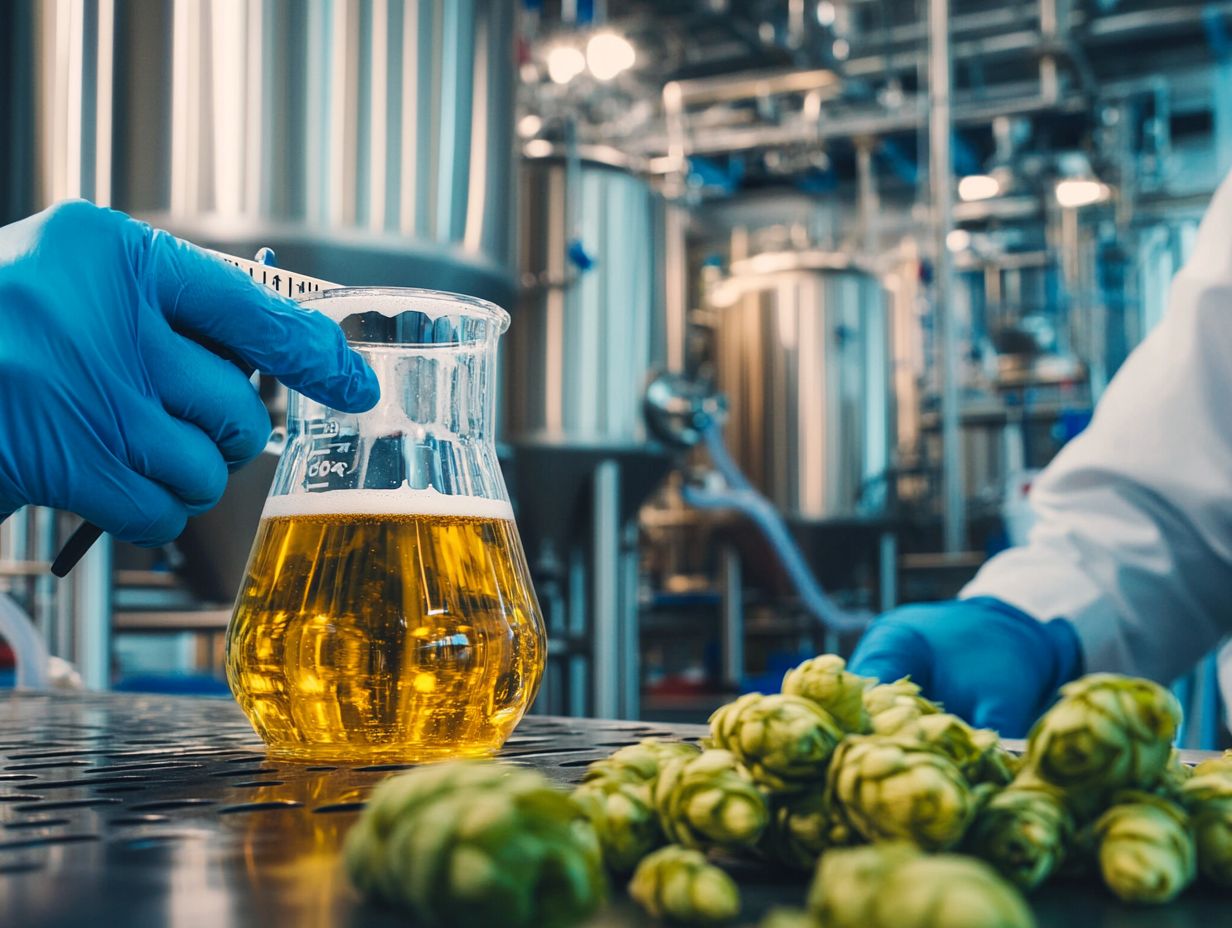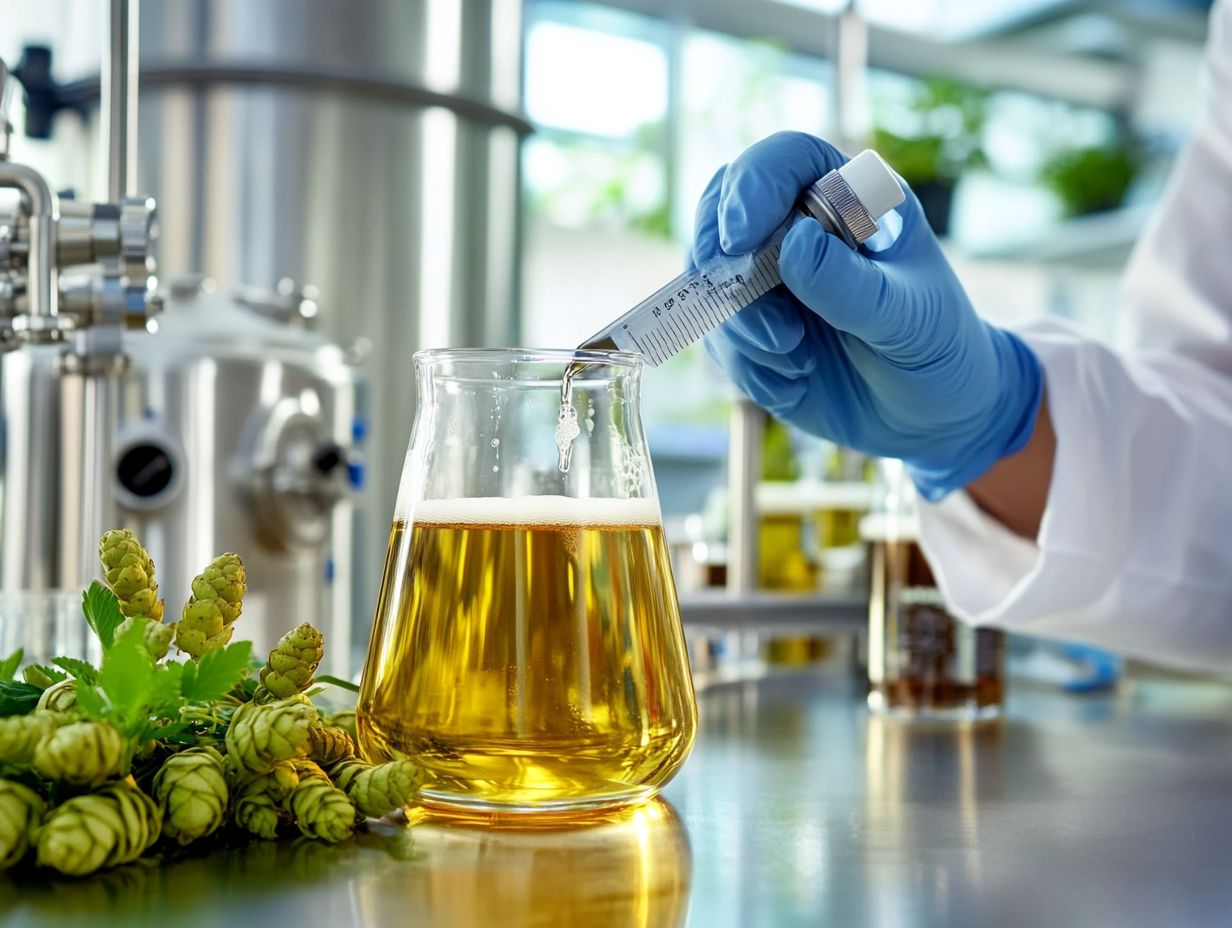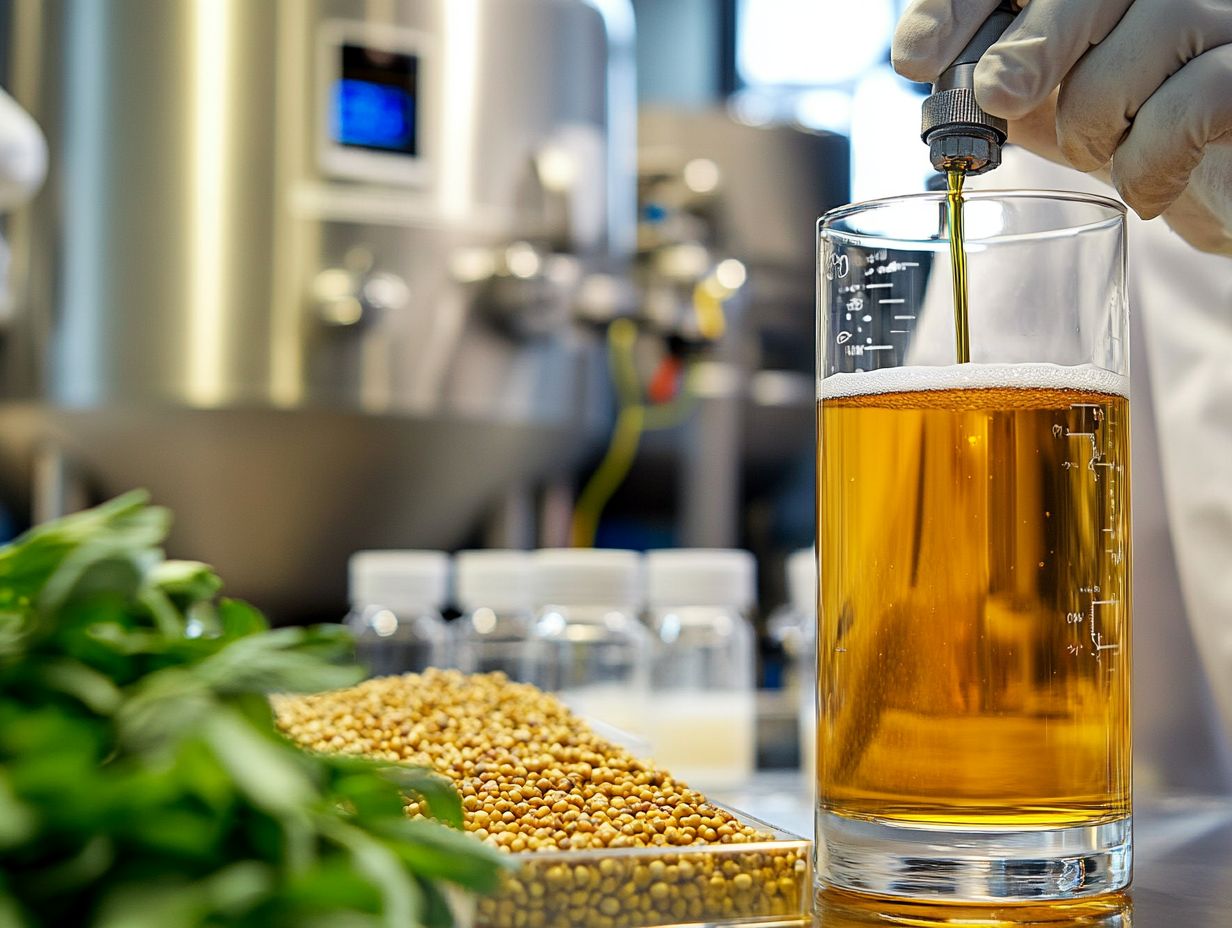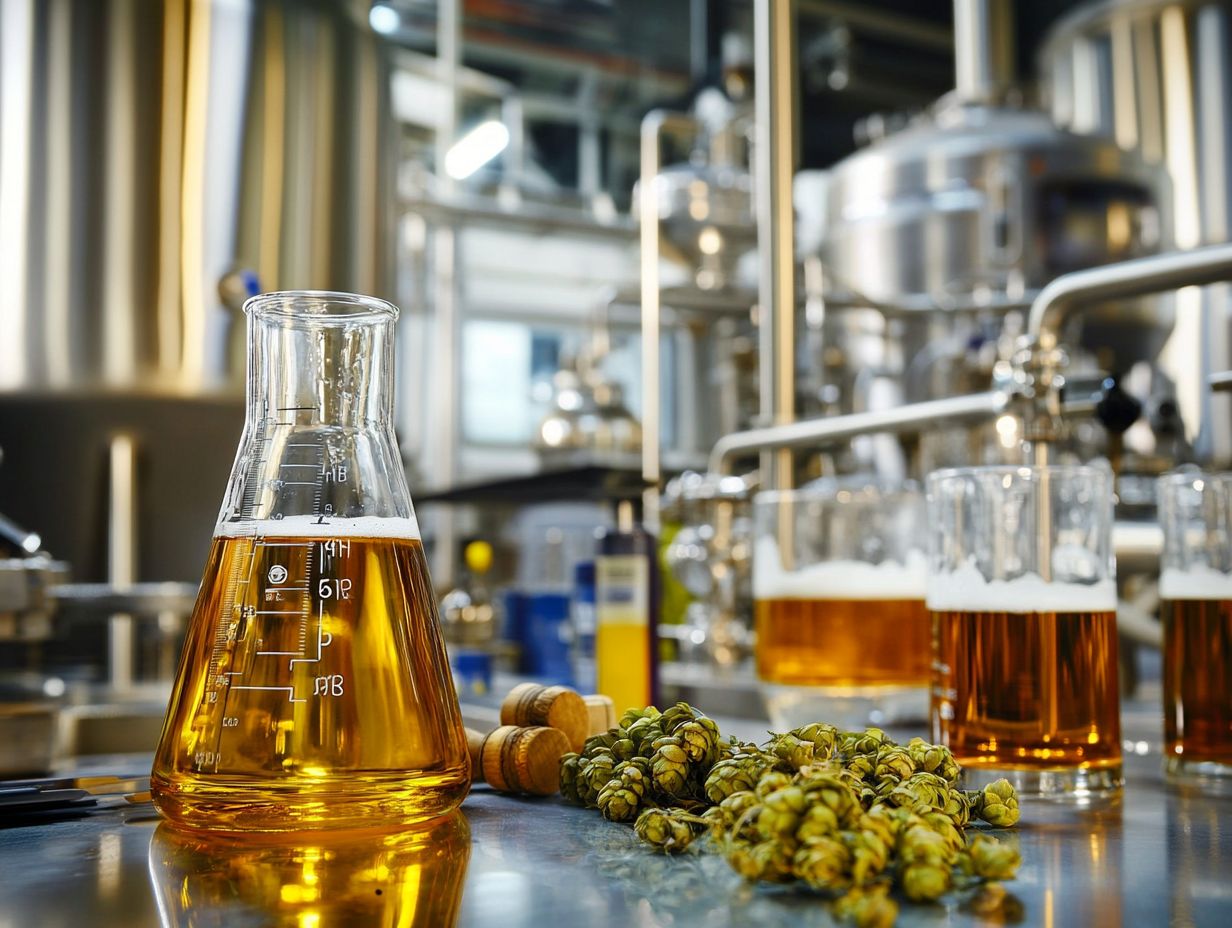The Role of pH in Brewing Issues
Understanding the role of pH in brewing is essential for you, whether you’re a passionate beer enthusiast or a professional brewer engaged in traditional brewing or home brewing.
This seemingly straightforward measurement can profoundly impact the flavor, beer quality, and overall success of your brewing endeavors. From your brewing water source to the grains, hops, and yeast, numerous factors can influence pH levels, leading to common fermentation problems and challenges that may jeopardize your brew.
This comprehensive guide delves into the significance of pH in brewing, the ideal levels you should aim for, and practical solutions to maintain optimal conditions for crafting a delicious beer.
Jump into the world of brewing and discover how mastering pH can take your creations to the next level!
Contents
- Key Takeaways:
- What Is the Importance of pH in Brewing?
- What Are the Ideal pH Levels for Brewing?
- What Factors Can Affect pH in Brewing?
- Common pH Issues in Brewing
- What Are the Common pH Issues in Brewing?
- How Can pH Issues in Brewing Be Resolved?
- Frequently Asked Questions
- How Does pH Affect the Flavor of Beer?
- Does pH Affect the Appearance of Beer?
- What Happens if the pH Level is Not Ideal?
- Preventing pH Issues in Brewing
Key Takeaways:

- pH plays an important role in the flavor and brewing process of beer.
- Ideal pH levels for brewing depend on factors like water source, grains, hops, and yeast.
- Maintaining proper pH in brewing results in consistent flavor, improved fermentation, longer shelf life, and cost savings.
What Is the Importance of pH in Brewing?
pH is an important factor in the brewing process, as it significantly impacts beer quality, fermentation efficiency, and the overall flavor profile of your final product.
For brewing enthusiasts like yourself, mastering pH management is essential to crafting exceptional beer that satisfies the discerning tastes of the brewing community.
By monitoring and adjusting the pH at different stages such as mashing and fermentation you can achieve the perfect balance, ensuring your fermented beverages are of the highest quality.
How Does pH Affect the Flavor of Beer?
The pH level during the brewing process plays a crucial role in shaping the flavor of your beer. It influences everything from the extraction of flavors in the mash to the final taste profile of your beverage.
Slightly acidic environments, particularly those with pH values around 5.2 to 5.5, are optimal for extracting the rich malt flavors essential in many beer styles, such as stouts and porters. These darker beers often present chocolatey and coffee-like undertones, intricately tied to their specific pH levels during mashing.
If the pH creeps above 5.5, you might encounter unwelcome flavors, resulting in a more astringent and less balanced beer.
Using brewing software can help you keep track of these levels more efficiently.
Consider sour ales, which thrive in lower pH conditions, enhancing fruity and tart notes. In contrast, the classic lager, brewed within a more neutral pH range, showcases those crisp, clean flavors you love. This shows how different beer styles are affected by pH levels.
This delicate interplay of pH not only alters the fermentation process but also defines the unique characteristics that brewing enthusiasts hold dear.
How Does pH Affect the Brewing Process?
pH plays a crucial role in your brewing journey, especially when it comes to mash pH. This directly influences enzyme performance, wort stabilization, and overall brewing efficiency. Maintaining these pH levels is critical whether you’re using advanced brewing technology or traditional brewing techniques.
It’s vital to maintain optimal pH levels, regardless of whether you’re employing traditional all-grain techniques or embracing modern extract brewing methods.
During the mash process, achieving a balanced pH is essential for the enzymes responsible for breaking down starches into sugars to work effectively. If pH levels sink too low or soar too high, enzyme activity may falter, resulting in incomplete fermentation or unwanted flavors in your final brew. Tools like a high-quality pH meter and precise measurements are essential.
Fluctuations in pH during fermentation can lead to issues like off-flavors or yeast stalls, underscoring the importance of vigilant monitoring and timely adjustments using pH buffers.
By understanding and managing pH in brewing, you can exert greater control over the entire process, elevating both flavor and quality in every batch you create.
What Are the Ideal pH Levels for Brewing?
The ideal pH levels for brewing generally hover between 5.2 and 5.6 during the mash. Variations emerge throughout the fermentation process. Using brewing software can help track these fluctuations.
These fluctuations are influenced by the specific beer style you are crafting. It is essential to pay attention to these nuances for optimal results.
What Factors Can Affect pH in Brewing?
Understanding pH in brewing is crucial for achieving brewing excellence. Several factors can influence the pH in your brewing process.
Consider the water source you choose, as it plays an important role. The types of grains and malts you select also contribute significantly, along with the hops you decide to incorporate.
The yeast’s performance during fermentation can also affect the final pH. Each element is vital in crafting the perfect brew.
1. Water Source
The water you use for brewing is absolutely critical. Its mineral content and pH can significantly affect both the brewing process and the final flavor of your beer. Many brewers tend to overlook the intricacies of their water.
Assessing its properties is essential for crafting a well-balanced beverage. Minerals like calcium sulfate and calcium chloride play an important role in your brewing journey, much like staple ingredients do in other recipes.
By adjusting their levels, you can achieve the desired pH necessary for optimal enzymatic activity during mashing. By carefully adjusting these minerals, you bring out the best flavors from the malt.
This meticulous manipulation influences the mouthfeel and overall character of your beer. By understanding how these minerals interact with different grains and hops, you can fine-tune your recipes.
This attention to detail ultimately leads to a consistently high-quality product that showcases the intended flavor profiles, elevating your brewing game to new heights.
2. Grains and Malts
Your choice of grains and malts plays an important role in determining the pH of the mash. Different grains contribute varying levels of acidity and alkalinity, influencing the overall chemistry of your brew.
For example, base malts like pale malt lean towards being more alkaline, while specialty malts such as roasted barley are on the acidic side of the spectrum. Using advanced brewing techniques can help in balancing these variations.
This variation can have a significant impact, especially in high-ratio mashes where the malt-to-grain ratio is elevated. When selecting grains, consider the flavor profiles as well as how these selections affect the pH balance of the mash.
You can fine-tune the pH by adding gypsum or calcium chloride after choosing your grains, ensuring optimal enzyme activity during the mashing process. Acid additions, such as lactic acid or phosphoric acid, can also be used.
This attention to detail is essential for efficient sugar extraction, ultimately influencing the quality of your final beer. Advanced brewing systems can facilitate these adjustments.
3. Hops

Hops play an important role in influencing pH levels during the brewing process, particularly during the boil. The acidity of certain hop varieties can greatly affect the overall pH of the wort.
The relationship between hops and pH shapes the final character of your beer. Different hop varieties come with unique levels of alpha acids and essential oils, which can alter the wort’s acidity in various ways. Alpha acids are compounds that contribute to bitterness, while essential oils add aroma and flavor.
If you use hops with a higher acid content, you may notice a substantial drop in pH. This creates a more acidic environment that can enhance the extraction of flavors and aromas during brewing.
This shift in pH can also impact yeast performance during fermentation, ultimately affecting the balance between bitterness and sweetness and contributing to the beer’s mouthfeel and clarity.
By understanding the specific attributes of the hop varieties you choose, you can fine-tune your brewing methods, leading to a more desirable and complex beer profile.
Common pH Issues in Brewing
Yeast plays a crucial role in your brewing process, as its performance during fermentation can significantly alter pH levels. This, in turn, impacts both the fermentation process and the quality of your beer.
Different yeast strains, particularly those like Kveik yeast, produce a variety of byproducts that can influence the acidity of the wort. This fluctuation in pH can either enhance or inhibit specific flavor characteristics, which are vital for crafting a well-balanced beer profile.
Understanding how yeast activity correlates with pH changes gives you the power to make informed decisions about your fermentation processes. By keeping a close eye on pH levels, you can make precise adjustments like adding acids or buffering agents to optimize yeast performance and maximize fermentation efficiency. Paying attention to these details leads to a superior final product.
What Are the Common pH Issues in Brewing?
In your brewing endeavors, you may encounter common pH issues such as excessively high or low pH levels, as well as fluctuations that can disrupt the fermentation process. Monitoring pH readings carefully can help mitigate these issues.
These inconsistencies can lead to considerable fermentation challenges, ultimately impacting both the clarity and quality of your beer. Using advanced brewing systems and innovative design can help address these issues.
1. High or Low pH Levels
Maintaining the right pH levels during brewing is crucial. It can profoundly impact fermentation and ultimately influence the flavor of your beer.
Advanced capabilities in brewing software can assist in maintaining these levels. For example, if the pH level is too high, you might encounter astringency that undermines the smoothness and overall drinkability of your brew. Adjustments using sparge water can help as well.
On the flip side, if the pH dips too low, you could end up with unwanted sour notes that stray from the intended flavor profile. To spot these issues, it s essential to regularly measure pH at various stages of the brewing process, from mashing to fermentation.
If you find the pH too high, you can add acidifying agents like citric or lactic acid. Conversely, low pH can be adjusted by incorporating alkaline salts. By grasping these dynamics, you ll ensure that your brewing process consistently produces high-quality beer.
2. Fluctuating pH Levels
Fluctuating pH levels during the brewing process can significantly disrupt fermentation, leading to inconsistent beer quality and undesirable flavors. These shifts in acidity arise from various factors, such as the type of malt you choose, the mineral content of your water, and even the environmental conditions that impact yeast activity.
If you don t carefully monitor pH levels, you risk skewing the fermentation environment, which can induce yeast stress and compromise the production of specific flavor compounds. You can tackle these challenges with advanced brewing technology, including pH meters and control systems that offer real-time monitoring.
By using these tools, you can make informed adjustments to stabilize pH levels, ensuring a more predictable fermentation process and, ultimately, a higher quality beer.
3. Mash pH
Mash pH is a critical component of brewing, wielding significant influence over enzyme activity, wort stabilization, and overall brewing efficiency.
To achieve the best results, it’s essential to maintain the ideal mash pH range, typically between 5.2 and 5.5. This range dramatically enhances the performance of vital enzymes involved in the process where starches are converted into sugars. Enzymes like alpha and beta amylase flourish in this slightly acidic environment, promoting optimal starch conversion and enhancing fermentation efficiency.
When you effectively manage mash pH in your brewing system, you can enjoy improved flavor extraction and vibrant color development, ultimately leading to a more balanced and appealing final product. By thoughtfully incorporating additives such as calcium sulfate or lactic acid, you can meticulously fine-tune your mash pH, ensuring consistent quality across batches while allowing the unique nuances of each beer style to shine through.
How Can pH Issues in Brewing Be Resolved?
You can effectively address pH issues in brewing through a range of methods. Consider adjusting your water chemistry, incorporating acid or alkaline additives, and diligently monitoring mash pH levels to maintain optimal conditions.
Each approach allows you to fine-tune your brewing process, ensuring the best possible results in flavor and quality.
How will you ensure your pH levels are on point for your next brew?
1. Adjusting Water Chemistry
Adjusting water chemistry is essential for managing pH levels since mineral content profoundly affects the brewing process. Specific minerals, like calcium sulfate (gypsum), can lower pH and enhance flavor extraction, which is beneficial for certain beer styles.
Alternatively, calcium chloride can also achieve a desirable pH balance, resulting in smoother flavors and promoting yeast health, which is vital for fermentation. By carefully integrating these minerals, you can tailor your water chemistry to create optimal conditions for fermentation, ultimately improving the overall quality of your final product. Understanding how these additions influence pH gives you the power to craft superior brews.
2. Using Acid or Alkaline Additives

Utilizing acid or alkaline additives can be a game-changer for adjusting pH levels during brewing, helping solve fermentation problems and ensuring you create the most optimal brewing conditions.
These additives are essential in fine-tuning the acidity or alkalinity of your brewing environment, which is critical for enhancing yeast performance and shaping the overall flavor profile of your brew. You can use options like phosphoric acid or lactic acid to lower the pH, while sodium bicarbonate serves to raise it. When applying these substances, it’s best to introduce them in small increments during the mash or boil stages, and always follow up with pH testing using reliable strips or meters.
Using pH buffers is also important because they help stabilize levels throughout the brewing process, preventing any drastic fluctuations that could adversely affect taste and quality. By grasping the significance of these components, you can cultivate a more controlled and successful brewing experience!
3. Monitoring and Adjusting Mash pH
Regularly monitoring and adjusting mash pH is essential for maintaining optimal brewing conditions and ensuring consistent beer quality.
Using tools like pH meters and specialized brewing software provides accurate insights and allows for real-time adjustments during the mash process, which are crucial for achieving the desired flavor profiles and overall stability of your beer. With the aid of brewing software, you can analyze historical data, enabling you to make informed decisions based on previous batches. This synergy between technology and traditional brewing practices gives you the power to refine your methods, adapt to various ingredients, and elevate the quality of your craft to new heights.
Benefits of Maintaining Proper pH in Brewing
By maintaining the proper pH levels in your brewing process, you unlock a multitude of benefits that elevate your craft! Enjoy consistent flavor and quality in every batch, enhance fermentation outcomes, extend the shelf life of your beers, and potentially save on costs. It s a simple yet powerful way to refine your brewing experience!
1. Consistent Flavor and Quality
Maintaining proper pH levels offers one of the most significant advantages: a consistent flavor profile and high-quality beer throughout your brewing journey. When you meticulously monitor and adjust the pH during fermentation, you greatly enhance the reliability of your final product. Optimal pH levels do more than just influence taste; they are crucial for the activity of yeast and the various microorganisms that play a role in fermentation.
As the process unfolds, even slight variations in pH can lead to marked differences in flavor, aroma, and mouthfeel. Thus, adhering to an ideal pH range not only ensures that your brewing ingredients work in perfect harmony but also encourages the production of desirable esters and phenols, ultimately elevating the overall quality and consistency of your beer.
2. Improved Fermentation
Effective pH management is essential for enhancing fermentation, as it fosters an optimal environment for yeast performance and activity throughout the brewing process.
This balance is vital, given that yeast flourishes best within a specific pH range, typically between 4.0 and 5.0. Maintaining this range allows for improved cellular functions and fermentation kinetics. When you ensure the pH remains at these ideal levels, yeast efficiently converts sugars into alcohol and carbon dioxide, streamlining the fermentation process.
Optimal pH levels also help minimize the production of undesirable byproducts, thereby elevating the overall flavor and aroma profiles of your final product. By mastering the control of pH, you can unlock the full potential of your fermentation, paving the way for a more successful and consistent outcome in your brews.
3. Longer Shelf Life
Maintaining the right pH levels is essential for achieving a longer shelf life for your beers, as it enhances brewing clarity and minimizes fermentation issues. The ideal pH range, typically between 4.0 and 5.0, is pivotal in determining the overall quality of your final product.
When your pH is balanced, it fosters optimal protein-polyphenol interactions, resulting in a clearer beer. This clarity not only elevates the visual allure of your beverage but also signifies effective filtration and stabilization. Additionally, maintaining optimum pH levels helps inhibit undesirable microbial activity during fermentation, significantly reducing the risk of spoilage that could compromise both flavor and freshness.
For brewers dedicated to crafting high-quality beer, grasping the nuances of pH can greatly enhance stability and longevity, ultimately leading to a more enjoyable experience for your consumers.
4. Cost Savings
Effective pH management can lead to substantial cost savings for you as a brewer, enhancing your brewing efficiency while reducing the risk of fermentation issues and product loss.
By diligently monitoring and adjusting pH levels throughout the brewing process, you can create optimal conditions for yeast activity, which is essential for crafting high-quality beverages. When you maintain the pH within a specific range, you’ll not only elevate the flavor profile but also significantly reduce the likelihood of off-flavors and spoilage.
This proactive approach to pH control streamlines your operations, allowing you to utilize resources more effectively, ultimately minimizing ingredient waste and fostering a more sustainable brewing practice. As a result, your brewery can emphasize consistent quality and produce exceptional beer while simultaneously lowering costs linked to spoilage and rework.
Frequently Asked Questions
How do pH buffers affect brewing?

Using pH buffers can help maintain the perfect balance necessary for brewing quality beer.
What is the role of pH in brewing issues?
Understanding pH management is vital for brewing enthusiasts and professionals alike.
For example, the use of BrauSupply and Unibr u systems can assist in maintaining optimal pH levels.
The pH level of a brewing solution plays a crucial role in many aspects of the brewing process, including flavor, aroma, color, and stability of the final product. Effective pH management ensures consistent beer quality and minimizes fermentation problems.
How Does pH Affect the Flavor of Beer?
Different brewing methods can change the acidity, which in turn affects the flavor.
Using sparge water to adjust pH can greatly influence the final taste.
The ideal acidity range for brewing beer is between 5.2 and 5.5. High acidity can make beer taste bitter, while low acidity can create sour flavors.
Does pH Affect the Appearance of Beer?
Yes! The acidity of the brewing solution can change the beer’s color. High acidity often leads to darker beer, while low acidity results in lighter colors.
Beer styles like Pilsen, Burton, Dortmund, and Framingham have unique acidity requirements that affect their color.
What Happens if the pH Level is Not Ideal?
If the acidity isn t right, yeast activity can slow down, which may lead to fermentation issues and affect the beer’s flavor and stability.
Proper pH management is vital to avoid problems and ensure quality beer.
Preventing pH Issues in Brewing
How can pH issues be prevented in the brewing process?
Brewers can prevent pH issues using advanced brewing technology. Understanding the role of alpha-amylase and beta-amylase, which are enzymes that help convert starches into sugars during fermentation, is also vital.
Having brewing resources and access to online information is beneficial. Utilizing brewing software can also assist in consistent pH management.
To ensure the pH level is within the ideal range, brewers can use pH strips or a pH meter to regularly test the solution during the brewing process. If necessary, adding acids like lactic acid or phosphoric acid can help adjust the pH.
Is pH the only factor that affects brewing issues?
No, while pH plays a significant role, other factors such as water quality, temperature, and ingredients can also impact the brewing process and final product. Elements like calcium chloride and calcium sulfate can influence the brewing profile.
Join the brewing community to learn from fellow brewing enthusiasts and gain insights into the broader aspects of brewing.
For instance, traditional brewing and all-grain brewing methods can yield different outcomes based on these variables. Brewing water, mash pH, and other variables are also significant.
Additionally, home brewing enthusiasts often explore different brewing techniques to optimize their results. Factors such as mash pH and brewing water quality also play crucial roles.
No, while pH plays a significant role, other factors such as water quality, temperature, and staple ingredients like calcium sulfate and calcium chloride can also impact the brewing process and final product.






